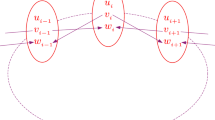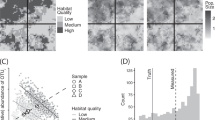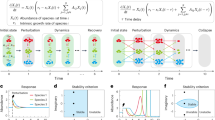Abstract
The study of synchronization phenomena in ecology is important because it helps to explain interactions between population dynamics and extrinsic environmental variation1,2,3,4,5. Grenfell et al.1 have examined synchronized fluctuations in the sizes of two populations of feral sheep which, although situated on close but isolated islands, were nevertheless strongly correlated (observed value of the population correlation, rp, 0.685). Using a nonlinear threshold model, they argue that this level of population correlation could only be explained if environmental stochasticity was correlated between the islands, with the environmental correlation, re, higher than 0.9 “on average” (Fig. 1a). This unusually high environmental correlation is far greater than would be predicted by the Moran effect2, which states that the population correlation will equal the environmental correlation in a linear system. Grenfell et al.1 imply that a simple nonlinearity in population growth can mask or even destroy the Moran effect1,3,4. Here we show that these surprising results are an artefact of the techniques used to measure noise correlations and synchronization.

a, Correlation between island sheep populations, rp , as a function of the model's noise parameters ra and rb (Fig. 3a of ref. 1). The model1 is set up so that ra and r b represent the correlation of the environmental noise affecting the two sheep populations when they are both either above or below threshold, respectively (see c for colour calibration). According to ref. 1, rp equals the observed value of ro = 0.658 only if the environmental correlations r a and rb are larger than “0.9 on average”. b, True environmental correlation, re, as a function of the model parameters ra and rb. To calculate re, we stored all environmental shocks received by each model sheep population and then simply determined their correlation: hence re is viewed as the correlation coefficient of shocks directly experienced by the two model sheep populations. The surface for re is almost identical to that of rp in a, demonstrating a Moran effect. c, Colour-coding of correlations depicted in a and b. d, Analysis of systems in which model environmental correlation parameters r = ra= rb (that is, systems along the diagonal of parameter space in a and b ). Red curve, cut through surface in a above the line r = ra = rb. The correlation between sheep populations rp is plotted against the model's environmental correlation parameter r; the deviation from the reference diagonal (black) seems to indicate the absence of a Moran effect, as argued in ref. 1. Blue curve, rp vs re, where re (horizontal axis) is the true environmental correlation (see b ). Note that this line is very close to the reference diagonal (black), where rp = r e, as predicted by the Moran effect. Magenta line, effects of small sample size (n = 18) due to statistical scattering in an ensemble of 1,000 simulation runs: for each value of environmental correlation r e (horizontal axis), 5% of the simulations have rp values larger than the value plotted. Green horizontal line, the measured correlation between the two observed sheep populations is ro = 0.685. The point of intersection of the green and magenta lines yields the minimum value of the ‘true environmental correlation’, r e, for which we can expect to find the observed sheep correlation by chance alone (that is, in at least 1 in 20 runs, or 5%, when r e = 0.3). Further details are available from the authors.
This is a preview of subscription content, access via your institution
Access options
Subscribe to this journal
Receive 51 print issues and online access
$199.00 per year
only $3.90 per issue
Buy this article
- Purchase on Springer Link
- Instant access to full article PDF
Prices may be subject to local taxes which are calculated during checkout
Similar content being viewed by others
References
Grenfell, B. T. et al. Nature 394, 674–677 (1998).
Moran, P. A. P. Aust. J. Zool. 1, 291–298 (1953).
Stenseth, N. C. & Chan, K.-S Nature 394, 620–621 (1998).
Hudson, P. J. & Cattadori, I. M. Trends Ecol. Evol. 14, 1–2 (1999).
Blasius, B. et al. Nature 399, 354–359 (1999).
Author information
Authors and Affiliations
Corresponding author
Rights and permissions
About this article
Cite this article
Blasius, B., Stone, L. Nonlinearity and the Moran effect. Nature 406, 846–847 (2000). https://doi.org/10.1038/35022646
Issue Date:
DOI: https://doi.org/10.1038/35022646
This article is cited by
-
Enhanced Moran effect by spatial variation in environmental autocorrelation
Nature Communications (2015)
-
Emergent Features Due to Grid-Cell Biology: Synchronisation in Biophysical Models
Bulletin of Mathematical Biology (2007)
-
Synchronization of animal population dynamics by large-scale climate
Nature (2002)
Comments
By submitting a comment you agree to abide by our Terms and Community Guidelines. If you find something abusive or that does not comply with our terms or guidelines please flag it as inappropriate.



